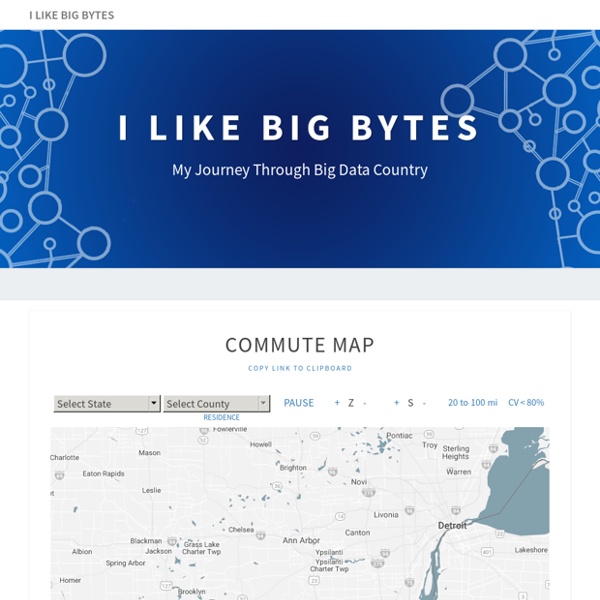



http://bigbytes.mobyus.com/commute.aspx
Related: Webmapping - Datavisualisations - Open data • Amérique du Nord - Continent américain et Brésil • `test 1023The globe of economic complexity About close x The Globe of Economic Complexity The globe of economic complexity dynamically maps out the entire world production of goods to create an economic landscape of countries around the globe. Here's Everyone Who's Immigrated to the U.S. Since 1820 From 1820 to 2013, 79 million people obtained lawful permanent resident status in the United States. The interactive map below visualizes all of them based on their prior country of residence. The brightness of a country corresponds to its total migration to the U.S. at the given time. Use the controls at the bottom to stop / resume the animation or to move back and forth in time. Two Centuries of U.S. Immigration (1 dot = 10,000 people)
Transforming Data into Visualization Data visualization explains a story to the user; a story that if told well should help the viewer discern information and relationships between the data. Data visualization, for a designer, is the process of taking a complex structure and breaking it down in a way that the reader can easily comprehend. It is a powerful tool used to translate complex data into accessible insights. In this article, I’ll explain the four critical steps we took to create a visualization graph for the World Economic Forum (WEF). Presenting gvSIG Online: the solution for Spatial Data Infrastructures on Open Source software During the last International gvSIG Conference a new product added to the gvSIG Association catalogue was presented for the first time. We think it will be well received because it meets an every time more and more need to have a solution for implementing Spatial Data Infrastructures, using open source software and reducing implementation costs of the current market alternatives. gvSIG Online is result of the experience accumulated by the gvSIG Association at the Spatial Data Infrastructure projects implementation of all types and in any sector, from petrol companies to local administrations. But, what is gvSIG Online? We can define the product in a few lines… “gvSIG Online is an integral platform for the Spatial Data Infrastructure (SDI) implementation, 100% open source software.
Exploring Mexico through Dynamic Web Maps One of the people I regard most highly here at Esri has created an online atlas of Mexico. He started it off as an Esri storymap, but as he continued to add content, it soon become a “story atlas.” As an educator I was immediately struck by how useful the atlas could be as a tool to teach and learn about Mexico. I am continually amazed and also hear from educators at how little American students really know about their neighbor to the south. Performance Philosophy - Plateforme internationale Performance Philosophy is an international research network for the field of Performance Philosophy. The network is open to all researchers concerned with the relationship between performance & philosophy. The network was founded by eleven core conveners in the summer of 2012 and was formally launched on the 3rd September 2012. Eleven new conveners were appointed in September 2017, with two of the founding conveners stepping down. Aims The core aims of Performance Philosophy are:
The Antiquities Coalition Site - Culture Under Threat Map LAYER: Areas Under Threat or Control of Terror Groups What it Displays: A heat map of areas that are under the direct control of terrorist groups or threatened by areas they have occupied between January and October 2015. Information from no earlier than 2015 was included due to the continually shifting nature of the MENA conflicts. The terrorist groups included in this map were based on terror groups as defined by the National Counterterrorism Center. Sources of Information: Institute for Study of War (ISW), the Carter Center Syrian Conflict Mapping Project, National Counterterrorism Center and international media reports on terror-controlled territories. LAYER: Heritage Sites Attacked, Targeted, or Destroyed
Indigenous Peoples and Natural Ecosystems in Central America and Southern Mexico Authors: Center for the Support of Native Lands and National Geographic Date Released: